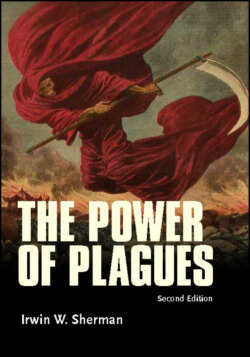Читать книгу The Power of Plagues - Irwin W. Sherman - Страница 38
Church
ОглавлениеIn cities of 50,000 people, more than 500 died each day. Priests who gave last rites had a very high mortality rate, and there was a loss of faith in the clergy because they seemed so powerless to prevent death or the spread of death from disease. There was also a decline in papal authority. The Church passed the responsibility for plague on to God, suggesting that this was Judgment Day, that people had sinned and so nothing could be done to reduce the suffering. All of the monks of a monastery near Avignon and another near Marseilles succumbed.
Fear of plague also led to a greater consciousness of religion, especially the “magical religion” embodied in the cults of healer saints. These patron saints, who not only knew suffering but also had the power to heal the sick and provide comfort, usurped the veneration of God alone and set the stage for long and divisive debates over the nature of religion. One of these healer saints was St. Sebastian, and another was St. Roch (Fig. 4.3). Although it is not known whether the life of St. Roch is truth or fiction, his story comes to us in written form in 1414 from the Venetian humanist and scholar Francisco Diedo. Roch was born in Montpellier, France, in 1295, and he is said to have had a birthmark in the form of a red cross on his breast. As a young man he gave to the poor and embarked on pilgrimages to Rome. Wherever he traveled there was plague, and he was able to cure the afflicted by placing his hands on the buboes. He eventually contracted the disease, was expelled from Montpellier, and died in 1327. St. Roch is often depicted as a pilgrim carrying a purse and a staff and pointing to a bubo on his inner thigh.
Figure 4.3 St. Roch, the patron saint of those suffering from plague. The original hangs in the Galleria Dell’ Academia, Venice, Italy, Courtesy Wikipedia.com
Another threat to the Church was a pilgrim movement of another sort. The Brethren of the Flagellants began in eastern Europe, but its strongest bases were in Germany and France. The flagellants, sometimes as many as a thousand, marched in procession through the town; they were led by a master carrying a banner of purple velvet and were dressed in cloth of gold. Masked and dressed in dark clothing emblazoned with a red cross, each flagellant carried a whip made of leather thongs and tipped with metal studs, with which they beat their backs and chests. (This is graphically shown in Goya’s painting of the flagellants as well as in Ingmar Bergman’s movie The Seventh Seal.) The flagellants were a counterculture to the Church, and they claimed divine authorization for their mission, the alleviation of the plague. Pope Clement VI initially encouraged the flagellant movement, and up until 1349 the flagellants had their way in recruiting other pilgrims, but when the pope saw he could not control it, he issued a bull denouncing the movement and its practices. Eventually the movement ceased for reasons not fully understood. In its time, however, the flagellant movement did some good: it brought about a spiritual revival, sinners confessed and robbers returned stolen property, hope was raised (albeit temporarily), and it provided a theatrical diversion. But in the final analysis, the movement did more harm than good. Jews became the special victims of the flagellants, and their persecutions were the forerunners of the pogroms. In Frankfurt in 1349 the flagellants rushed into the Jewish quarter and incited the people to engage in wholesale slaughter. In Brussels the mere announcement of their arrival triggered a massacre of 600 Jews. Death from the Black Death itself coupled with that due to virulent anti-Semitism virtually wiped out Jewish communities in many parts of Europe and also led to permanent shifts in their populations to Poland and Lithuania.
